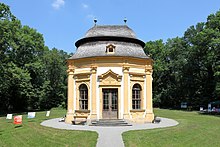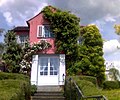Garden shed

Under a garden shed , colloquially gazebo or arbor , refers to a building that in the garden of a residential building, in the basic meaning small garden or pleasure garden is, but not built for temporary residence for permanent living. An arbor in the strict sense of the word, on the other hand, is a building that is not completely closed and offers the opportunity to stay as sun or rain protection. These are often in a garden shed to a small building, therefore, often from garden shedIn other words, the garden shed always includes at least one enclosed space. Garden houses can have very different characteristics. You can e.g. B. have the character of a simple hut , an arbor with attached locked room or that of a free-standing, airy, but locked pavilion or lounge , sometimes also the character of a simple small single-family house . If a "garden shed" is only used to store garden tools and materials, it is more likely to be referred to as a tool shed .
Deviating from this basic meaning, a garden house can also mean an ordinary house that is arranged in the garden or on the property behind the main house facing the street. This terminology is particularly widespread in Berlin tenements . A (Berlin) Garden house is a normal multi-storey residential building as a rear cross-building ( rear building ).
history
Classicist style garden houses were built in the gardens of town houses in the first half of the 19th century. They were used for recreation and for civil representation. The cellars of the houses also had practical use as wine cellars. The vineyard house is a special type of garden shed .
Often, especially in the 19th century, wealthy citizens had a garden house built in the same style as their home.
Construction and regulations
The usual construction is solid masonry or wood. For a concrete construction, there are kits made of prefabricated solid components. Wooden houses are often used as a prefabricated kit z. B. sold in hardware stores. If a foundation is laid before construction , this generally extends the durability and stability of a wooden garden house.
The place where a new garden house is to be built is also important. Different rules apply in your own garden than in an allotment garden, for example. The Federal Allotment Garden Act explicitly allows a house called an arbor in a simple design with a maximum of 24 square meters of floor space including a covered patio . Garden houses whose area exceeds this size require a building permit. Also, the nature of the house, especially its equipment and furnishings, must not be suitable as a permanent residence .
For this reason, many allotment gardens do not have connections to the sewer system and the power grid .
In the past, however, this question was dealt with more generously, for example after the Second World War , when the prevailing housing shortage meant that many garden houses had to be used as a replacement for the owner's apartment that had been destroyed and were extended (mostly without a building permit) on their own. Often their (strictly speaking illegally resident) residents were later granted a lifelong right of residence in order to avoid social hardship. Today this sometimes leads to conflicts if heirs or buyers of such a makeshift home believe that it is an approved residential building.
The Princely House in Meersburg
Garden house in Hardtpark Lennep
See also
- Datsche , weekend house
- Goethe's garden house , Schiller's garden house
- Garden house (Hanover)
- Tiny House Movement
Web links
- Section 3 of the Federal Allotment Garden Act (BKleingG)






